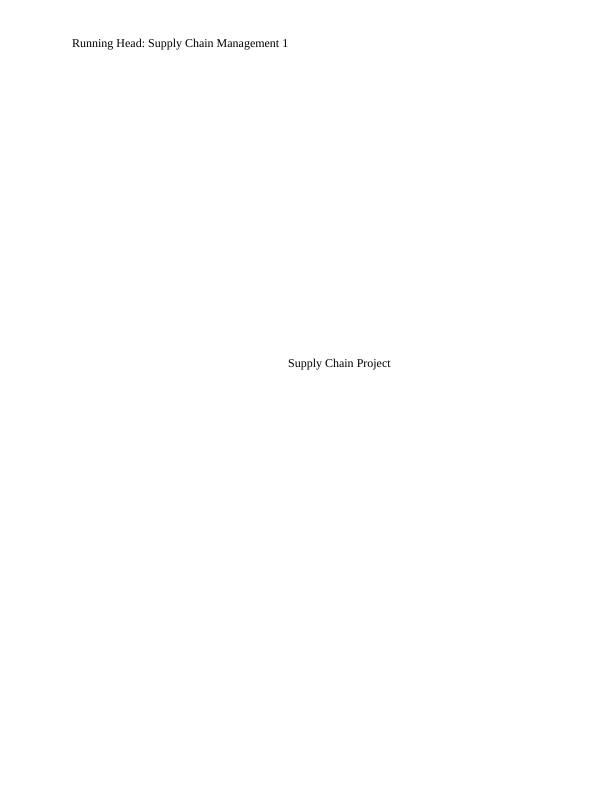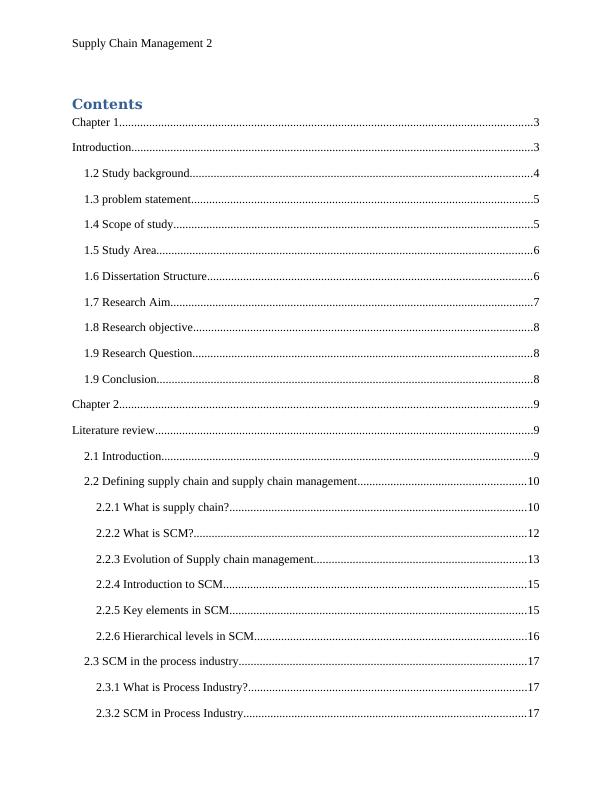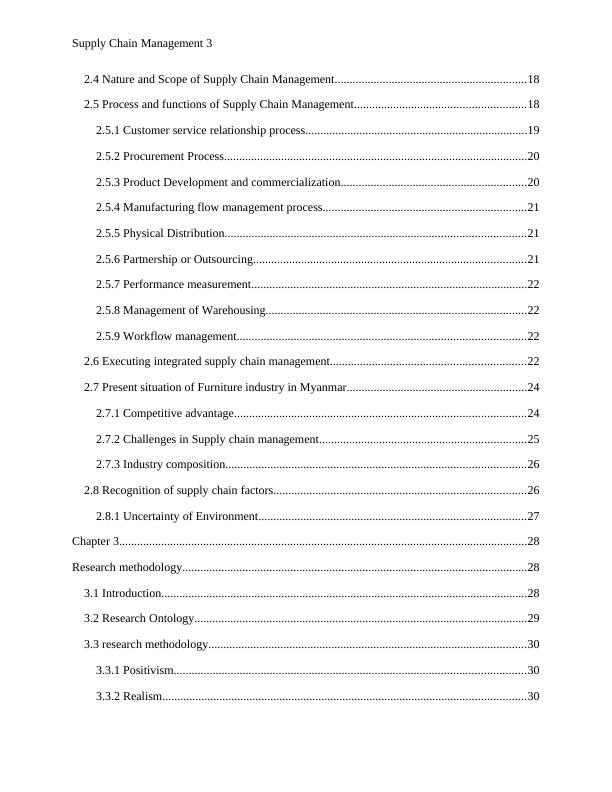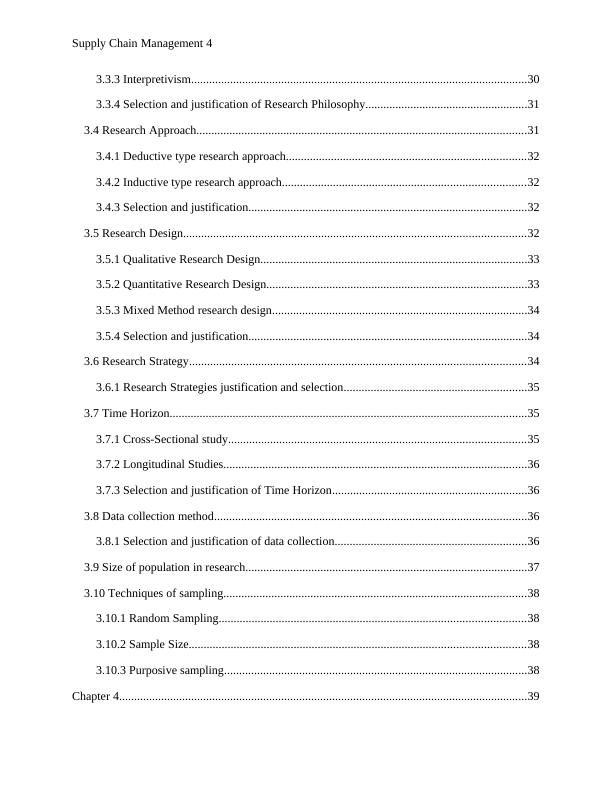Ask a question from expert
Supply Chain Management 65 Running Head: Supply Chain Management
71 Pages20533 Words482 Views
Added on 2020-04-21
About This Document
Supply Chain Management 65 Running Head: Supply Chain Management 1 Supply Chain Management 1 Supply Chain Management Project Contents Chapter 1 3 Introduction 3 1.2 Study background 4 1.3 problem statement 5 1.4 Scope of study 5 1.5 Study Area 6 1.6 Dissertation Structure 6 1.7 Research Aim 7 1.8 Research objective 8 1.9 Research Question 8 1.9 Conclusion 8 Chapter 2 9 Literature review 9 2.1 Introduction 9 2.2 Defining supply chain and supply chain management 10 2.2.1 What is supply chain?
Supply Chain Management 65 Running Head: Supply Chain Management
Added on 2020-04-21
BookmarkShareRelated Documents
Running Head: Supply Chain Management 1
Supply Chain Project
Supply Chain Project

Supply Chain Management 2
Contents
Chapter 1..........................................................................................................................................3
Introduction......................................................................................................................................3
1.2 Study background..................................................................................................................4
1.3 problem statement..................................................................................................................5
1.4 Scope of study........................................................................................................................5
1.5 Study Area.............................................................................................................................6
1.6 Dissertation Structure............................................................................................................6
1.7 Research Aim.........................................................................................................................7
1.8 Research objective.................................................................................................................8
1.9 Research Question.................................................................................................................8
1.9 Conclusion.............................................................................................................................8
Chapter 2..........................................................................................................................................9
Literature review..............................................................................................................................9
2.1 Introduction............................................................................................................................9
2.2 Defining supply chain and supply chain management........................................................10
2.2.1 What is supply chain?...................................................................................................10
2.2.2 What is SCM?...............................................................................................................12
2.2.3 Evolution of Supply chain management.......................................................................13
2.2.4 Introduction to SCM.....................................................................................................15
2.2.5 Key elements in SCM...................................................................................................15
2.2.6 Hierarchical levels in SCM...........................................................................................16
2.3 SCM in the process industry................................................................................................17
2.3.1 What is Process Industry?.............................................................................................17
2.3.2 SCM in Process Industry..............................................................................................17
Contents
Chapter 1..........................................................................................................................................3
Introduction......................................................................................................................................3
1.2 Study background..................................................................................................................4
1.3 problem statement..................................................................................................................5
1.4 Scope of study........................................................................................................................5
1.5 Study Area.............................................................................................................................6
1.6 Dissertation Structure............................................................................................................6
1.7 Research Aim.........................................................................................................................7
1.8 Research objective.................................................................................................................8
1.9 Research Question.................................................................................................................8
1.9 Conclusion.............................................................................................................................8
Chapter 2..........................................................................................................................................9
Literature review..............................................................................................................................9
2.1 Introduction............................................................................................................................9
2.2 Defining supply chain and supply chain management........................................................10
2.2.1 What is supply chain?...................................................................................................10
2.2.2 What is SCM?...............................................................................................................12
2.2.3 Evolution of Supply chain management.......................................................................13
2.2.4 Introduction to SCM.....................................................................................................15
2.2.5 Key elements in SCM...................................................................................................15
2.2.6 Hierarchical levels in SCM...........................................................................................16
2.3 SCM in the process industry................................................................................................17
2.3.1 What is Process Industry?.............................................................................................17
2.3.2 SCM in Process Industry..............................................................................................17

Supply Chain Management 3
2.4 Nature and Scope of Supply Chain Management................................................................18
2.5 Process and functions of Supply Chain Management.........................................................18
2.5.1 Customer service relationship process..........................................................................19
2.5.2 Procurement Process.....................................................................................................20
2.5.3 Product Development and commercialization..............................................................20
2.5.4 Manufacturing flow management process....................................................................21
2.5.5 Physical Distribution....................................................................................................21
2.5.6 Partnership or Outsourcing...........................................................................................21
2.5.7 Performance measurement............................................................................................22
2.5.8 Management of Warehousing.......................................................................................22
2.5.9 Workflow management................................................................................................22
2.6 Executing integrated supply chain management.................................................................22
2.7 Present situation of Furniture industry in Myanmar............................................................24
2.7.1 Competitive advantage.................................................................................................24
2.7.2 Challenges in Supply chain management.....................................................................25
2.7.3 Industry composition....................................................................................................26
2.8 Recognition of supply chain factors....................................................................................26
2.8.1 Uncertainty of Environment.........................................................................................27
Chapter 3........................................................................................................................................28
Research methodology...................................................................................................................28
3.1 Introduction..........................................................................................................................28
3.2 Research Ontology...............................................................................................................29
3.3 research methodology..........................................................................................................30
3.3.1 Positivism.....................................................................................................................30
3.3.2 Realism.........................................................................................................................30
2.4 Nature and Scope of Supply Chain Management................................................................18
2.5 Process and functions of Supply Chain Management.........................................................18
2.5.1 Customer service relationship process..........................................................................19
2.5.2 Procurement Process.....................................................................................................20
2.5.3 Product Development and commercialization..............................................................20
2.5.4 Manufacturing flow management process....................................................................21
2.5.5 Physical Distribution....................................................................................................21
2.5.6 Partnership or Outsourcing...........................................................................................21
2.5.7 Performance measurement............................................................................................22
2.5.8 Management of Warehousing.......................................................................................22
2.5.9 Workflow management................................................................................................22
2.6 Executing integrated supply chain management.................................................................22
2.7 Present situation of Furniture industry in Myanmar............................................................24
2.7.1 Competitive advantage.................................................................................................24
2.7.2 Challenges in Supply chain management.....................................................................25
2.7.3 Industry composition....................................................................................................26
2.8 Recognition of supply chain factors....................................................................................26
2.8.1 Uncertainty of Environment.........................................................................................27
Chapter 3........................................................................................................................................28
Research methodology...................................................................................................................28
3.1 Introduction..........................................................................................................................28
3.2 Research Ontology...............................................................................................................29
3.3 research methodology..........................................................................................................30
3.3.1 Positivism.....................................................................................................................30
3.3.2 Realism.........................................................................................................................30

Supply Chain Management 4
3.3.3 Interpretivism................................................................................................................30
3.3.4 Selection and justification of Research Philosophy......................................................31
3.4 Research Approach..............................................................................................................31
3.4.1 Deductive type research approach................................................................................32
3.4.2 Inductive type research approach.................................................................................32
3.4.3 Selection and justification.............................................................................................32
3.5 Research Design..................................................................................................................32
3.5.1 Qualitative Research Design.........................................................................................33
3.5.2 Quantitative Research Design.......................................................................................33
3.5.3 Mixed Method research design.....................................................................................34
3.5.4 Selection and justification.............................................................................................34
3.6 Research Strategy................................................................................................................34
3.6.1 Research Strategies justification and selection.............................................................35
3.7 Time Horizon.......................................................................................................................35
3.7.1 Cross-Sectional study...................................................................................................35
3.7.2 Longitudinal Studies.....................................................................................................36
3.7.3 Selection and justification of Time Horizon.................................................................36
3.8 Data collection method........................................................................................................36
3.8.1 Selection and justification of data collection................................................................36
3.9 Size of population in research..............................................................................................37
3.10 Techniques of sampling.....................................................................................................38
3.10.1 Random Sampling......................................................................................................38
3.10.2 Sample Size................................................................................................................38
3.10.3 Purposive sampling.....................................................................................................38
Chapter 4........................................................................................................................................39
3.3.3 Interpretivism................................................................................................................30
3.3.4 Selection and justification of Research Philosophy......................................................31
3.4 Research Approach..............................................................................................................31
3.4.1 Deductive type research approach................................................................................32
3.4.2 Inductive type research approach.................................................................................32
3.4.3 Selection and justification.............................................................................................32
3.5 Research Design..................................................................................................................32
3.5.1 Qualitative Research Design.........................................................................................33
3.5.2 Quantitative Research Design.......................................................................................33
3.5.3 Mixed Method research design.....................................................................................34
3.5.4 Selection and justification.............................................................................................34
3.6 Research Strategy................................................................................................................34
3.6.1 Research Strategies justification and selection.............................................................35
3.7 Time Horizon.......................................................................................................................35
3.7.1 Cross-Sectional study...................................................................................................35
3.7.2 Longitudinal Studies.....................................................................................................36
3.7.3 Selection and justification of Time Horizon.................................................................36
3.8 Data collection method........................................................................................................36
3.8.1 Selection and justification of data collection................................................................36
3.9 Size of population in research..............................................................................................37
3.10 Techniques of sampling.....................................................................................................38
3.10.1 Random Sampling......................................................................................................38
3.10.2 Sample Size................................................................................................................38
3.10.3 Purposive sampling.....................................................................................................38
Chapter 4........................................................................................................................................39

Supply Chain Management 5
Results and discussion...................................................................................................................39
4.1 Introduction..........................................................................................................................39
4.2 Demographic profile of the respondents and respond rate..................................................39
4.2.1 Profile of respondents...................................................................................................39
4.2.2 Survey questionnaire response rate..................................................................................41
4.3 Comparison of collected data and objectives......................................................................42
4.4 Survey questionnaire...........................................................................................................42
4.4.1 Section 1: Result...........................................................................................................42
Chapter 5........................................................................................................................................64
Conclusion and recommendations.................................................................................................64
Conclusion.................................................................................................................................64
5.1 Findings...............................................................................................................................64
5.2 Limitations of the study.......................................................................................................66
Chapter 6........................................................................................................................................66
Recommendations..........................................................................................................................66
6.1 Needs for future research.....................................................................................................66
6.2 General recommendations...................................................................................................67
Results and discussion...................................................................................................................39
4.1 Introduction..........................................................................................................................39
4.2 Demographic profile of the respondents and respond rate..................................................39
4.2.1 Profile of respondents...................................................................................................39
4.2.2 Survey questionnaire response rate..................................................................................41
4.3 Comparison of collected data and objectives......................................................................42
4.4 Survey questionnaire...........................................................................................................42
4.4.1 Section 1: Result...........................................................................................................42
Chapter 5........................................................................................................................................64
Conclusion and recommendations.................................................................................................64
Conclusion.................................................................................................................................64
5.1 Findings...............................................................................................................................64
5.2 Limitations of the study.......................................................................................................66
Chapter 6........................................................................................................................................66
Recommendations..........................................................................................................................66
6.1 Needs for future research.....................................................................................................66
6.2 General recommendations...................................................................................................67

Supply Chain Management 6
Chapter 1
Introduction
The perception of supply chain management (SCM) is considered as the one of the most
appropriate and applied methods which is basically used to enhance the management in terms of
economic and productivity. The process of supply chain includes all the operations which are
directly and indirectly focusing on satisfying the needs and demands of the customers. In the
supply chain, all the retailers, suppliers, transporters, warehouses, retailers, producers and
customers are connected with it. In an organization, the objective of a producer is to acquire and
satisfy the demands and requirements of the customers which are incorporated with the supply
chain. The function of supply chain includes development of the new products, various
operations, delivery of the finished products, marketing and finance operations and other services
for the customers etc.
According to the American Expert Association, the concept of supply chain management
can be described as the arrangements of all the activities as well as administrations such as in-
sourcing, transformation, agreements and logistics management activities for better business
operations. Basically, supply chain management also incorporates with the suppliers which may
be intermediaries, clients, third-party service providers, and channel partners. The demand and
supply is basically managed by the supply chain management in the companies.
In current time, the competition in the market is continuously and in the era of IT
development, it is important and first priority for the companies to satisfy the customers to
survive in the market. The needs and wants of the customers include affordable rates, on time
transportation and delivery and high quality products and services. In simple words, supply chain
management is the approach which focuses on satisfying all the requirements of the customers
by providing them final products along with the higher suppliers. In other words, the approach of
supply chain also considers the suppliers in the business operations. The process of supply chain
is focused on meeting the needs and wants of suppliers. Supply chain approach includes various
operational segments within an organization such as planning related to strategic and production,
Chapter 1
Introduction
The perception of supply chain management (SCM) is considered as the one of the most
appropriate and applied methods which is basically used to enhance the management in terms of
economic and productivity. The process of supply chain includes all the operations which are
directly and indirectly focusing on satisfying the needs and demands of the customers. In the
supply chain, all the retailers, suppliers, transporters, warehouses, retailers, producers and
customers are connected with it. In an organization, the objective of a producer is to acquire and
satisfy the demands and requirements of the customers which are incorporated with the supply
chain. The function of supply chain includes development of the new products, various
operations, delivery of the finished products, marketing and finance operations and other services
for the customers etc.
According to the American Expert Association, the concept of supply chain management
can be described as the arrangements of all the activities as well as administrations such as in-
sourcing, transformation, agreements and logistics management activities for better business
operations. Basically, supply chain management also incorporates with the suppliers which may
be intermediaries, clients, third-party service providers, and channel partners. The demand and
supply is basically managed by the supply chain management in the companies.
In current time, the competition in the market is continuously and in the era of IT
development, it is important and first priority for the companies to satisfy the customers to
survive in the market. The needs and wants of the customers include affordable rates, on time
transportation and delivery and high quality products and services. In simple words, supply chain
management is the approach which focuses on satisfying all the requirements of the customers
by providing them final products along with the higher suppliers. In other words, the approach of
supply chain also considers the suppliers in the business operations. The process of supply chain
is focused on meeting the needs and wants of suppliers. Supply chain approach includes various
operational segments within an organization such as planning related to strategic and production,

Supply Chain Management 7
transportation planning, supply control, identifying locations and various settings etc. Supply
chain management basically is a the network of various organizations where they develop values
by connecting high level management to lower level in various activities and procedures and
provide valuable products to then customers or end users. The method of supply also includes
some legally separated firms that are connected with each other by information, material, and
financial purpose. Certainly, these organizations are those which produce goods and manufacture
ultimate goods. All the suppliers in the manufacturing, distribution and logistics services and
customers can be included in this procedure. Initially, a system does not only rely on any kind of
chain in the development but also, it includes on the convergent and divergent system or process
along with various orders from the consumers which must be fulfilled on time.
The higher level of management in the furniture companies are focused on analyzing the
situations of the concept integrated supply chain management for the future perspective. In this
report, the role and significance of supply chain in the contemporary time is described along with
the critical circumstances for the furniture traders and transportation automobiles.
1.2 Study background
In the era of stable development and development, fiscal development, strong
macroeconomic essentials, and managerial transforms are motivating Myanmar’ industrial and
business sector to expand and invest in more business areas. The new firms are setting the strong
industrialization focus along with the plans to set themselves in the most critical economic
development in the future. There is the need to create employment and foundation ventures along
with the continuous development in the extraordinary economic zones. These processes would
attract new manufacturing and individual investments in the new business ventures. In the year
2015, the GDP rate was around 20% in the manufacturing segment which was two times of its
share i.e. 11%. In the manufacturing industry, the growth of foreign direct investment shows a
quick development and now in 2015, it has increased by 75%. In retail sector of Myanmar is
extended by 7 to 15% from 2012 to 2012 along with GDP development of 7% over the same
period of time. In spite of various challenges and threats, many of retailers are assuming to
achieve significant growth and development within the set time-frame.
Focusing on the retail and industrial sector of Myanmar, the history of the nation is
considered along with the difficulties which the country is facing in terms of strong competition
transportation planning, supply control, identifying locations and various settings etc. Supply
chain management basically is a the network of various organizations where they develop values
by connecting high level management to lower level in various activities and procedures and
provide valuable products to then customers or end users. The method of supply also includes
some legally separated firms that are connected with each other by information, material, and
financial purpose. Certainly, these organizations are those which produce goods and manufacture
ultimate goods. All the suppliers in the manufacturing, distribution and logistics services and
customers can be included in this procedure. Initially, a system does not only rely on any kind of
chain in the development but also, it includes on the convergent and divergent system or process
along with various orders from the consumers which must be fulfilled on time.
The higher level of management in the furniture companies are focused on analyzing the
situations of the concept integrated supply chain management for the future perspective. In this
report, the role and significance of supply chain in the contemporary time is described along with
the critical circumstances for the furniture traders and transportation automobiles.
1.2 Study background
In the era of stable development and development, fiscal development, strong
macroeconomic essentials, and managerial transforms are motivating Myanmar’ industrial and
business sector to expand and invest in more business areas. The new firms are setting the strong
industrialization focus along with the plans to set themselves in the most critical economic
development in the future. There is the need to create employment and foundation ventures along
with the continuous development in the extraordinary economic zones. These processes would
attract new manufacturing and individual investments in the new business ventures. In the year
2015, the GDP rate was around 20% in the manufacturing segment which was two times of its
share i.e. 11%. In the manufacturing industry, the growth of foreign direct investment shows a
quick development and now in 2015, it has increased by 75%. In retail sector of Myanmar is
extended by 7 to 15% from 2012 to 2012 along with GDP development of 7% over the same
period of time. In spite of various challenges and threats, many of retailers are assuming to
achieve significant growth and development within the set time-frame.
Focusing on the retail and industrial sector of Myanmar, the history of the nation is
considered along with the difficulties which the country is facing in terms of strong competition

Supply Chain Management 8
from neighborhood. The country is suitable for the international investments and the country is
opening the door of success for the world as well as ASEN economic community. The country is
full of youthful, dedicated, proficient and influenced people who are effective for the successful
business ventures. By analyzing all the situations and real upsides, it is observed that the country
has ability to deal with various critical situations like political factors which is the key
component for the improvement.
1.3 problem statement
The process of executing, controlling as well as managing various operations of the
supply chain is effective and reasonable in the process and this is called supply chain
management. The process of supply includes storage and improvements of raw material, work in
process of inventory and final products from the starting to their consumptions. In current time,
the furniture businesses in Myanmar are facing some challenges in terms of quality of the supply
chain management and implementation of the new methods and technologies in business
operations. It is important now to improve the capacity of the process of supply chain
management in Myanmar for fulfilling the rules and regulations and standard at the global level
and competing with the local workforce to stay competitive.
1.4 Extent of study
It is well-known that the furniture manufacturing sector of Myanmar is now being
marginalized. Customers are now spending their money on other operating costs rather furniture
expenses. This factor is the base for the research in this project report. It is suggested that the
furniture manufacturer must be more creative to stay competitive in the market of low share and
focus on meeting the expectations of the investors and stakeholders. There are many challenges
and threats which can be analyzed in the furniture industry. Those challenges must be addressed
in the effective way to enhance the performance of the organizations in the industry. The extent
of the study will focus on the concept of supply chain management. The topic of supply chain
management is now famous in all over the world and managers in the respective organizations
are seeking for new and innovative ways to promote the concept of supply chain management.
This research basically includes some wide range of issues which are identified in the industry.
Those issues are described below:
from neighborhood. The country is suitable for the international investments and the country is
opening the door of success for the world as well as ASEN economic community. The country is
full of youthful, dedicated, proficient and influenced people who are effective for the successful
business ventures. By analyzing all the situations and real upsides, it is observed that the country
has ability to deal with various critical situations like political factors which is the key
component for the improvement.
1.3 problem statement
The process of executing, controlling as well as managing various operations of the
supply chain is effective and reasonable in the process and this is called supply chain
management. The process of supply includes storage and improvements of raw material, work in
process of inventory and final products from the starting to their consumptions. In current time,
the furniture businesses in Myanmar are facing some challenges in terms of quality of the supply
chain management and implementation of the new methods and technologies in business
operations. It is important now to improve the capacity of the process of supply chain
management in Myanmar for fulfilling the rules and regulations and standard at the global level
and competing with the local workforce to stay competitive.
1.4 Extent of study
It is well-known that the furniture manufacturing sector of Myanmar is now being
marginalized. Customers are now spending their money on other operating costs rather furniture
expenses. This factor is the base for the research in this project report. It is suggested that the
furniture manufacturer must be more creative to stay competitive in the market of low share and
focus on meeting the expectations of the investors and stakeholders. There are many challenges
and threats which can be analyzed in the furniture industry. Those challenges must be addressed
in the effective way to enhance the performance of the organizations in the industry. The extent
of the study will focus on the concept of supply chain management. The topic of supply chain
management is now famous in all over the world and managers in the respective organizations
are seeking for new and innovative ways to promote the concept of supply chain management.
This research basically includes some wide range of issues which are identified in the industry.
Those issues are described below:

End of preview
Want to access all the pages? Upload your documents or become a member.
Related Documents
Managing International Businesslg...
|69
|20400
|72
XXX in China: Marketing Strategies for Expansionlg...
|68
|16736
|25
Impact of Leadership style on Employee Performance: A case study of HSBClg...
|87
|19011
|452
STRM044 : Business Research Projectlg...
|70
|15996
|60
Methods of Sampling and Data Collection in Statisticslg...
|5
|758
|214
British Airways Logistics and Supply Chain Management : Case Studylg...
|49
|11800
|181